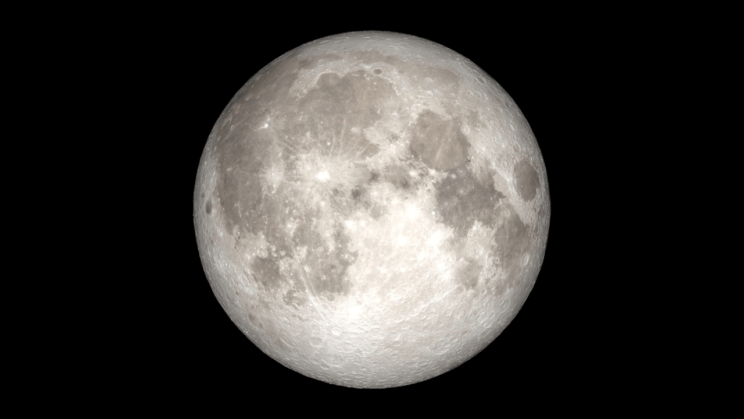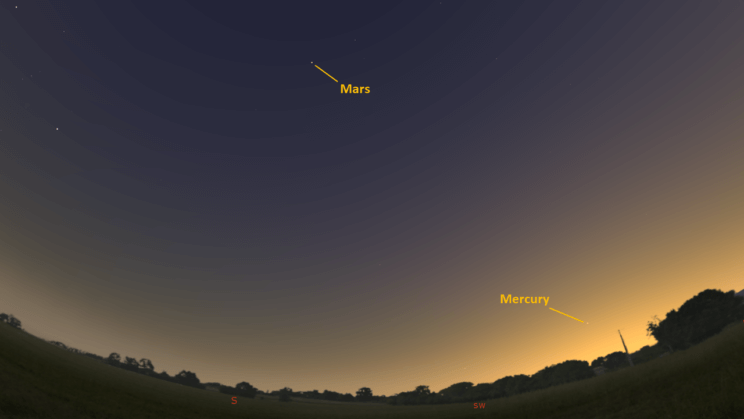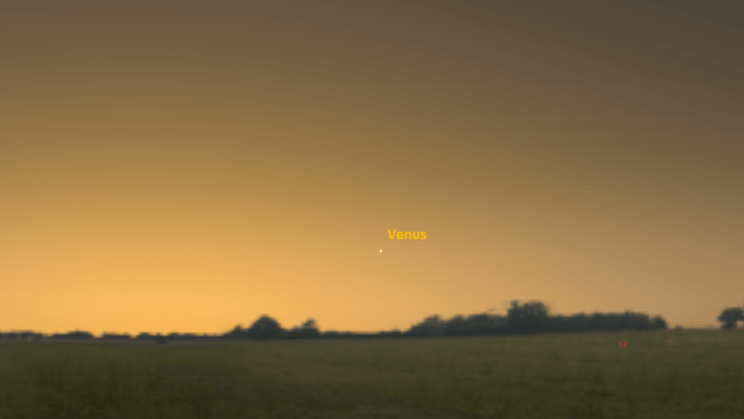This is the Saint Louis Science Center’s NIGHT SKY UPDATE for the week of Friday, January 29, 2021.
Information updated weekly or as needed.
Times given as local St. Louis time which is Central Standard Time (CST). For definitions of terminology used in the night sky update, click the highlighted text. If relying on times posted in Universal Time (UT), St. Louis is now -6 Hours from UT.
Public Telescope Viewings
Star parties at the Saint Louis Science Center have temporarily been canceled due to recommendations from the CDC regarding COVID-19. All public telescope events are canceled until further notice. As conditions change, we will reevaluate and update this article once public observing events resume.

Full Moon
Credit: NASA, SVS, Ernie Wright
Observing Highlight of the Week
Observing the Moon offers backyard astronomers a chance to explore several interesting topics beyond observing lunar features. Lunar cycles offer us a means to keep time, predict high and low tides, predict eclipses among several other things. Tracking the cycles of the Moon has had a direct impact on the success of human society.
Cycles of the Moon are called months. Our calendar month is based on the lunar phase cycle which is called a synodic month. The synodic cycle takes roughly 29.5 days to complete. Before we had solar calendars, humans used the moon phases to track time. This fell out of favor as human society transitioned to agriculture. With this change tracking the cycle of the seasons became more important. Since the synodic month is 29.5 days there are 12.4 synodic cycles in a solar year. Due to this a lunar calendar dose not sync with the cycle of the seasons.
Tracking moon phases can still be beneficial. Those that live near waterfronts will know that moon phases can inform high and low tides. For backyard astronomers and imagers, the moon phase has a direct impact on whether we will have a successful night. The closer we are to full moon, the brighter it will be outside and as such this has a direct impact on whether we see something.
Tracking the moon phase along with two other types of lunar cycles helps us understand when and where eclipses can be seen. For an eclipse to occur, two things need to happen. First, the moon must be at new or full moon. The phase determines if the eclipse is solar or lunar. A Solar eclipse occurs when it is new moon, and a lunar eclipse occurs when it is full moon. This is tracked with the Moon’s synodic cycle. The second factor is the Moon must be at a crossing node which is when its orbital path crosses the Earth’s ecliptic. This happens twice a month but it does always occur at new or full moon. This behavior of the Moon is tracked with the draconic month which takes about 27.2 days to occur.
Lastly, how far the Moon is from Earth can impact the type of eclipse we experience. In the Moon’s orbit there is a near and far point which are called apsides. The difference is not huge, but it does impact how large the Moon appears to us. Most are familiar with this lunar behavior due to what many now call a supermoon. The cycle of lunar apsides is called an anomalistic month which takes about 27.5 days to occur. This cycle has the greatest impact on a solar eclipse as it is what helps determine if there will be an annular (moon near far point) or a total solar eclipse (moon near close point).
In 2021, there are two lunar eclipse visible from St. Louis. The first is a total lunar eclipse on May 26, 2021 and the second is a partial lunar eclipse on November 19, 2021. For us in St. Louis, the November 19 partial lunar eclipse will be the best placed for viewing.
Full moon occurred on January 28, 2021. A great way to start learning about the Moon and its cycles will be to track the Moon through its phases. Go outside for the next month and track when you can find the Moon. Did you see it at the same time? Was it in the same position amongst the background stars? Could you find it in the daytime? These are all questions that will help you understand and master the lunar cycles.
The Sun and Moon

The Moon as seen from the International Space Station, on July 31, 2011.
Credit: NASA
Sunrise is at 7:09 a.m. on Friday, January 29 and sunset is at 5:20 p.m. providing us over 10 hours of daylight. Even after sunset, the light from the Sun will dimly illuminate our sky for about 1 hour and 30 minutes. This period is called twilight, which ends around 6:51 p.m. this week. For those with a sundial, local noon occurs around 12:15 p.m. this week.
| Day | Sunrise | Sunset |
|---|---|---|
| 2021-01-29 | 7:09 a.m. | 5:20 p.m. |
| 2021-01-30 | 7:08 a.m. | 5:21 p.m. |
| 2021-01-31 | 7:07 a.m. | 5:22 p.m. |
| 2021-02-01 | 7:07 a.m. | 5:23 p.m. |
| 2021-02-02 | 7:06 a.m. | 5:25 p.m. |
| 2021-02-03 | 7:05 a.m. | 5:26 p.m. |
| 2021-02-04 | 7:04 a.m. | 5:27 p.m. |
| 2021-02-05 | 7:03 a.m. | 5:28 p.m. |
| 2021-02-06 | 7:02 a.m. | 5:29 p.m. |
Moon
Moonrise for Friday, January 29 occurs at 6:24 p.m. and moonset will occur at 8:39 a.m. on the following day. On Friday, January 29 the Moon will exhibit a waning gibbous phase with 99% of the lunar disk illuminated. Last quarter moon occurs on February 4 at 11:37 a.m.
International Space Station (ISS) Observing

Visible passes of ISS from St. Louis for the week of January 29 occur during evening hours. The best passes this week occur on the evenings of February 4 and 5. Use the table below for information about these and other visible passes this week.
Catch ISS from St. Louis starting Friday, January 29
| Date | Starts | Max. altitude | Ends | |||||||
|---|---|---|---|---|---|---|---|---|---|---|
| Time | Alt. | Az. | Time | Alt. | Az. | Time | Alt. | Az. | ||
| 31 Jan | -1.7 | 18:54:03 | 10 | NNW | 18:55:46 | 18 | N | 18:55:46 | 18 | N |
| 01 Feb | -1.7 | 18:06:59 | 10 | NNW | 18:08:58 | 15 | NNE | 18:10:35 | 11 | NE |
| 01 Feb | -0.9 | 19:42:56 | 10 | NW | 19:43:34 | 15 | NW | 19:43:34 | 15 | NW |
| 02 Feb | -3 | 18:55:39 | 10 | NW | 18:58:30 | 38 | NNE | 18:58:30 | 38 | NNE |
| 03 Feb | -2.5 | 18:08:26 | 10 | NNW | 18:11:22 | 26 | NNE | 18:13:34 | 14 | E |
| 03 Feb | -1.2 | 19:45:05 | 10 | WNW | 19:46:35 | 22 | W | 19:46:35 | 22 | W |
| 04 Feb | -3.5 | 18:57:32 | 10 | NW | 19:00:53 | 68 | SW | 19:01:51 | 42 | SSE |
| 05 Feb | -3.8 | 18:10:07 | 10 | NW | 18:13:28 | 68 | NE | 18:16:50 | 10 | ESE |
| 06 Feb | -1.2 | 19:00:02 | 10 | W | 19:02:37 | 21 | SW | 19:05:13 | 10 | S |
Magnitude (Mag): The Measure of brightness for a celestial object. The lower the value is, the brighter the object will be.
Altitude (Alt): The angle of a celestial object measured upwards from the observer’s horizon.
Azimuth (Az): The direction of a celestial object, measured clockwise from an observer’s location with north being 0°, east being 90°, south being 180° and west being 270°.
For information about ISS flyovers and other visible satellites, visit www.heavens-above.com
Detailed information regarding all unmanned exploration of our universe, missions past, present, and planned, can be found at Jet Propulsion Laboratories:
The Visible Planets

Looking Southwest, at 5:45 pm, January 29, 2021
Credit: Stellarium, EG, WS

Looking Southeast, 6:50 am, January 30, 2021
Credit: Stellarium, EG
This week, three naked eye planets are visible. Mercury be difficult to see just after sunset and Mars is found high in the south after sunset. Venus can be found in the southeastern sky before sunrise.
Mercury
Mercury is ending its first evening apparition of 2021. There are only one or two days remaining to try and find Mercury before we lose it to the glare of the Sun. Head outside about 30 to 40 minutes after sunset and look to the southwest on Friday and Saturday for our final chances to see Mercury some time.
Venus
Venus rises at 6:30 a.m. and will be visible around 7:00 a.m. Venus remains a morning object until March 26, 2021 when it reaches superior conjunction.
Mars
Currently Mars appears as a 0.3-magnitude object that will be visible high in the south about 30 minutes after sunset. Mars sets by 12:52 a.m. We are still near enough to Mars that surface features are visible through telescopes. Earth is moving away from Mars which means Mars is getting fainter each night. The observing season for this apparition ends around March 10, 2021 and superior conjunction occurs on October 7, 2021.
Uranus
Uranus is not a planet we normally include in this section. Even at its dimmest, the giant planet does hover within naked eye visibility. That said, it is so close to the visible limit of the human eye it just is not reality for most of us to see Uranus without binoculars or a telescope. You can find Uranus in the constellation Aries the Ram. The current magnitude for Uranus is 5.8. A finder chart for Uranus can be found here.
James S. McDonnell Planetarium
Night Sky Update: January 29-February 6, 2021






